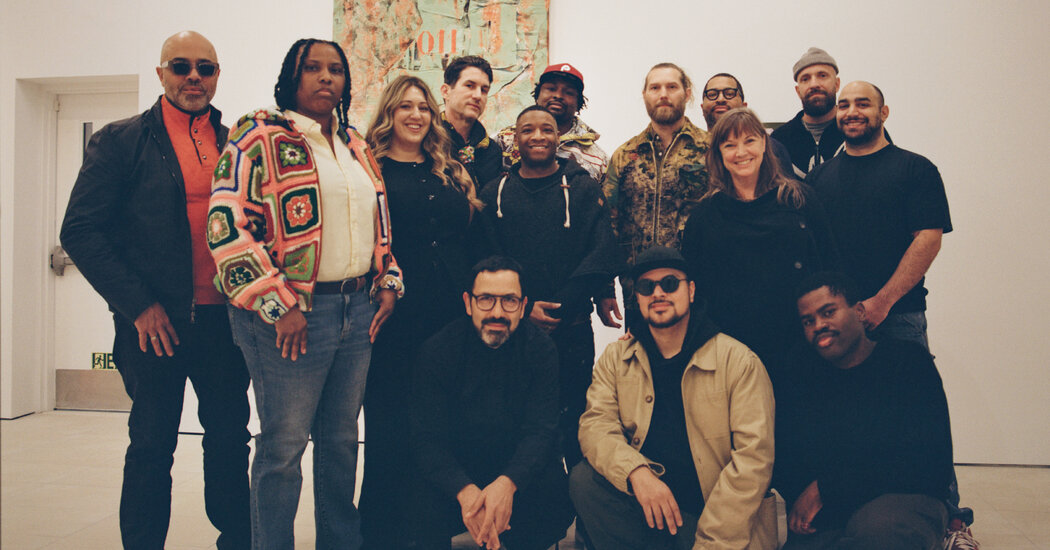
Center for Art and Advocacy Opens Showcase for Formerly Incarcerated Artists
The Center for Art and Advocacy, a nonprofit that assists artists who have served time in prison, will inaugurate its first physical space on Thursday. The hub, in the Bedford-Stuyvesant neighborhood of Brooklyn, opens to the public with an exhibition, “Collective Gestures: Building Community Through Practice,” featuring works by the organization’s fellows.
Jesse Krimes, the center’s founder and executive director, who has leveraged his successful art career to help other formerly incarcerated artists, says the center’s home “is a learning space and exhibition venue where we’re trying to get our artists out into the art world.”
The exhibition includes visual art, writing and film by recipients of the center’s interdisciplinary fellowship. The $20,000 award has been granted to 42 recipients since the program began in 2017. Beyond fellowships, the center offers mentoring, professional development and creative opportunities to its cohort of artists.
“Collective Gestures” was curated by Krimes and Kate Fowle, the chairwoman of the center’s board and the former director of MoMA PS1, where she brought the groundbreaking “Marking Time: Art in the Age of Mass Incarceration” in 2020 during her tenure. All the work in “Collective Gestures” is for sale, at prices from $5,000 to $40,000. The artists will receive 100 percent of the proceeds for their art (as opposed to a typical 50-50 split at commercial galleries).
The 2,600-square-foot ground-floor space, housed in a recently built mixed-use business development, is a concrete next step in Krimes’s long-term vision to amplify the perspectives of formerly incarcerated artists nationwide.
“People can show up and discover the work,” said Fowle. “When you think about the sustainability for an organization,” she added, “this is where we can invite everybody to feel like they’re actually participating.”
Dawanna Williams, a principal developer on the project, which includes 236 residential units, all designated as affordable housing, said she believed the center would add to the cultural fabric and local economy of Bed-Stuy. “Given its mission,” she said, “I think the center will provide a strong sense of belonging for the people in our apartment building.”
The opening exhibition showcases work by artists including Mary Enoch Elizabeth Baxter, Tameca Cole, Gary Harrell, Jared Owens and Beverly Price. The nonprofit has paid for its fellows to travel to the opening and has programming planned for them on Saturday at the Metropolitan Museum of Art. Artists will do a walk-through there of the exhibition “Jesse Krimes: Corrections,” including two installations he made covertly during his six years in prison: “Apokaluptein: 16389067” (2010-13), a monumental allegory of heaven, Earth and hell he made covertly by transferring newspaper images onto 39 bedsheets using hair gel, and “Purgatory” (2009), with images transferred onto bars of soap, which was recently acquired by the Met.
The fellows will then meet with Met staff members in a town-hall-style dialogue. The guiding question of that conversation will be how an institution can support formerly incarcerated artists, said the center’s deputy director, Carly Fischer, who joined Krimes and Fowle last week for an interview at the new space. From the findings at the Met town hall, Fischer said, “we can share a tool kit with art institutions across the country” who are interested in partnerships.
“We’re basically developing a curriculum program that other institutions can take on and scale,” added Krimes, who will give an artist’s talk at the Met on April 22. His exhibition there is on view through July 13, and he had his first solo gallery show with Jack Shainman in November.
“We hope other galleries steal all of our artists,” he said. “We don’t want to be in the business of representing artists.” (The only fellows currently represented by galleries are Jamie Diaz at Daniel Cooney, Sherrill Roland at Tanya Bonakdar and Gary Tyler at Library Street Collective.)
The center is visible from the street through a glass entrance opening to a wide corridor and wall of custom shelving with cubbyholes, pegboards and stools designed by the architect Koray Duman. This foyer will be a reading room with books by the center’s writing fellows, including Reginald Dwayne Betts (a MacArthur Fellow); Faylita Hicks; Randall Horton; and Mitchell S. Jackson (a Pulitzer winner), and with publications on the topics the artists are exploring.
“It’s a threshold space,” said Fowle, adding that she hopes it will invite people in. On the facing wall is a mural, designed by Krimes, in which he integrated fragments of work by the 42 fellows on large trapezoidal shapes that fan out in circular formation, echoing the center’s logo. “I layered it in similar ways as ‘Apokaluptein’,” he said. (This time he used a digital printer rather than hair gel.)
In the large central gallery space, Duman has designed three smaller movable walls that can pivot to create more intimate rooms for film screenings or poetry readings. “It can accommodate each practice in different ways,” Krimes said. He projected an annual operating budget of $1.2 million.
Since receiving an initial grant in 2016 from Open Philanthropy to co-found the fellowship with his friend Russell Craig, when both men were struggling to find their footing after prison, Krimes has proved to be an effective spokesman and fund-raiser for their movement.
Agnes Gund’s Art for Justice Fund, which wound down in 2023 after giving more than $127 million over six years to artists and activists working to end mass incarceration, left the center a significant legacy grant as well as its listserv. “We manage the entire community that was built from Art for Justice,” Krimes said. “Not just artists but advocates working across the country, thousands of people.”
The center is also receiving $2.5 million over three years for operating support from the Mellon Foundation, and smaller grants from the Arison Arts Foundation and the Hearthland Foundation, founded by the director Steven Spielberg and the artist Kate Capshaw, who is now on the center’s board.
Another $1.7 million came through a 2022 Christie’s auction to benefit the center, most of it from a painting donated by the artist Rashid Johnson, who had been recruited by Fowle to offer mentorship and feedback to the fellows.
“I’m interested in supporting good art being made,” Johnson said, adding that the obstacles shared by the fellows “continue to help inform how they come to the challenge in their projects.” The center has just established the Rashid Johnson Residency-at-Large Award, an 18-month program of mentorship and support for one selected fellow culminating in a solo exhibition in the new space. The original fellowship will also be ongoing, with a new cohort of six selected annually from the hundreds of applications that come in from artists across disciplines.
For the poet and filmmaker Asia Johnson, who was selected for the 2019 class of fellows shortly after coming home at age 32 from nine years in prison, the recognition changed the trajectory of her life.
“It didn’t just give me capital, it gave me the wherewithal and audacity to say I’m going to be a filmmaker,” Johnson said. She has just finished co-directing her first feature-length documentary, “Beyond,” and is represented in “Collective Gestures” by a music video.
“This space actually gives us power, it gives us visibility, it gives us hope,” said Johnson, now a board member. “And it gives that to the community at large — to be able to walk into a space and see humanity, see beautiful things and see love by people who may or may not have made mistakes in their lives.”
Collective Gestures: Building Community Through Practice
Through Sept. 20; Wednesdays through Sundays, 11 a.m. to 6 p.m., Center for Art and Advocacy, 22 Bancroft Place, Brooklyn.










